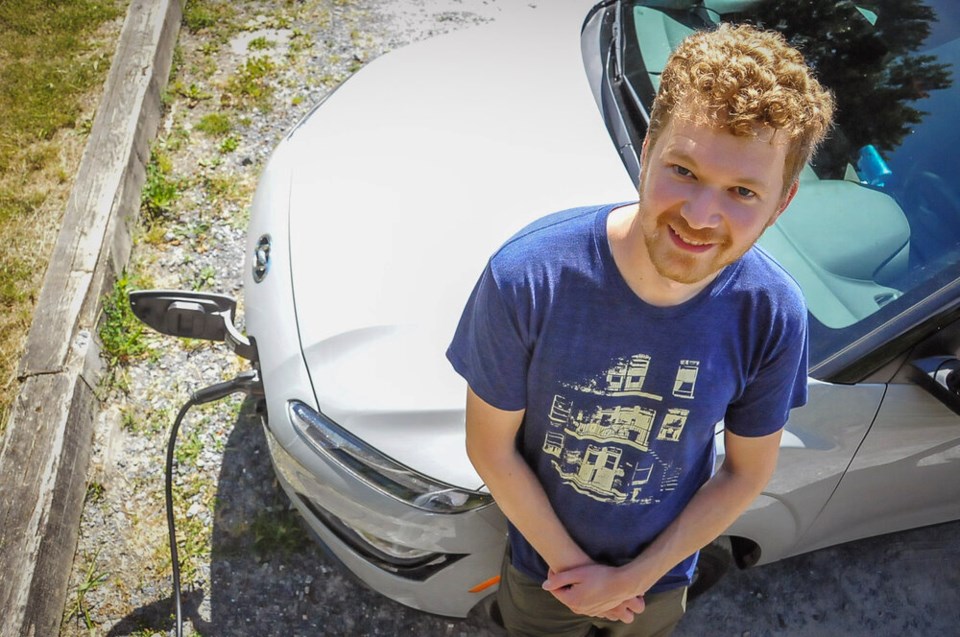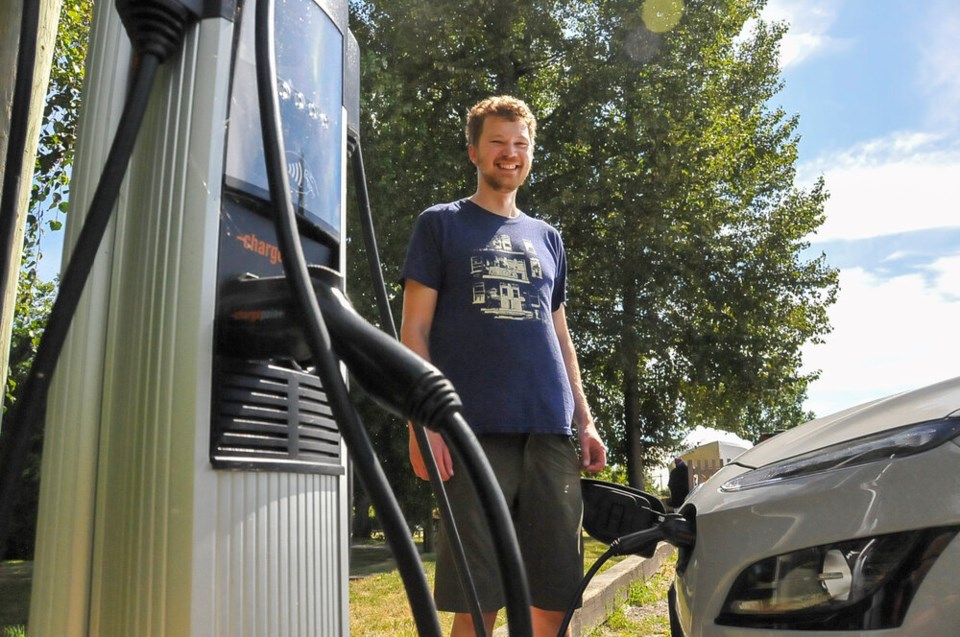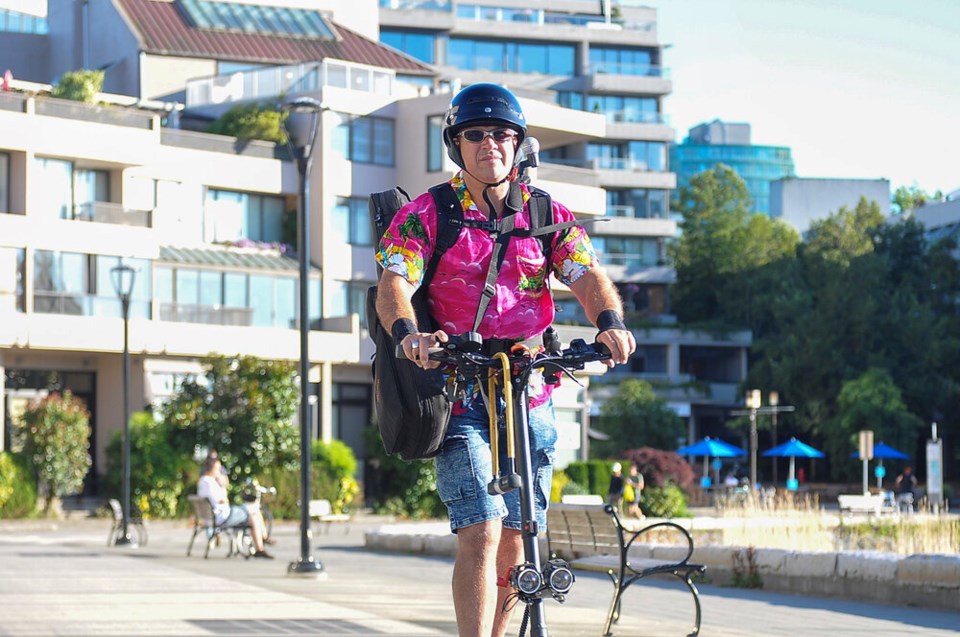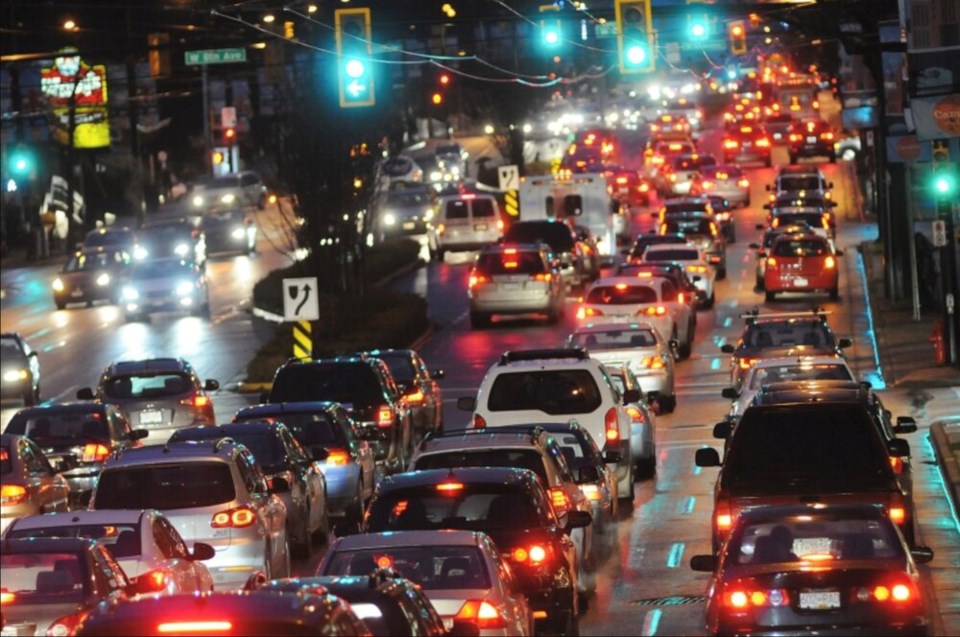Over a quarter million vehicles were added to British Columbia’s roads over the last six years. But over half of those hit the pavement in 2021 — a spike that has touched nearly every community in the province and threatens to undermine emission reduction targets.
According to public data from ICBC and Canada’s national census, the 2021 surge in vehicle ownership is outpacing population growth in dozens of communities across B.C.
“Overall, this level of private vehicle adoption in such a short amount of time is very bad news,” said Alex Bigazzi, head of UBC’s Research on Active Transportation Lab.
“Definitely a big step backwards from our climate goals.”
Until 2019, several medium and large cities across the province had made slow but significant gains driving down the number of cars on the road, even as their populations grew.
In 2020, the pandemic hit and vehicle ownership plunged, dropping the number of cars in dozens of B.C. municipalities into negative growth. But almost all municipalities had those gains wiped out in 2021, according to public data.
The province’s largest city, Vancouver, has long aspired to be the greenest in the world. But in 2021, residents registered more than 29,000 new vehicles, more than double the previous five years combined.
That means that since 2016, the number of vehicles in Vancouver grew triple the rate of its population, said Bigazzi, who reviewed Glacier Media’s analysis.
Nearly every large and medium city in B.C. saw vehicle ownership soar in 2021 — dozens by double digits.
On Vancouver Island, in the five years ending in 2020, several medium and small cities saw their car populations either level out or decline.
Langford jumped from a 1.49 per cent increase in cars over five years ending in 2020, to a nearly 24 per cent increase by 2021.
The municipalities of Sooke, Lake Cowichan, Cumberland, Tofino, Golden and Pemberton all saw their fortunes similarly reversed, with spikes in vehicle populations between 20 and 25 per cent over 2016 levels.
Victoria added over 2,300 cars to its roads in 2021, more than the previous five years combined.
And in Kelowna, where the number of newly registered cars had inched up by just over one per cent between 2016 and 2020, vehicle populations soared by over 14 per cent last year.
It’s not hard to see why, say experts.
The COVID-19 pandemic sent many employees to work from home, and telecommuting meant many could work further from the downtown core.
And while commuting plummeted, . Without international travel, many turned to explore locations closer to home.
“[They’re] kind of baked in, these changes, so they’re going to be with us for the long-term, which in the transportation world is 10-plus years,” said Bigazzi, who himself registered a vehicle for the first time during the pandemic.
Cars' rising toll
There are a lot of good reasons why cities want to reduce the number of cars and trucks on their roads.
Vehicle collisions kill roughly 280 people every year in B.C., and over the last five years, a yearly average of almost 1,400 cyclists and 2,100 pedestrians have been injured in such incidents.
That’s just what the average person can see. In the Lower Mainland, the most urbanized corner of the province, road traffic is among the leading cause of air pollution.
One recent long-term study in Metro Vancouver found noise and air pollution from traffic could reduce a child’s chances of hitting ; another found air pollution and a lack of green space make children .
And according to a led by the University of British Columbia's Michael Brauer, even low levels of air pollution from trucks and cars kill almost 8,000 Canadians every year.
Then there’s the role vehicles play in changing the planet’s climate system.
In B.C., emissions from cars and trucks have been climbing steadily over the past several decades, so that by 2019 — the last year public data is available — more than a quarter of British Columbia’s carbon pollution came from road transportation.
“Let’s be honest: transportation was the poorest performing sector, climate-wise, before the pandemic,” said Bigazzi. “And this makes it worse, it makes it much worse.”
So far, solutions to reduce emissions have focused on getting people out of cars and onto buses, trains and bicycles, or shifting people over to electric vehicles.
At all levels of government, that has meant investments in , funding the , and big projects to build out public transportation.
In cities, transforming how the average person gets around is an incredibly complex task that involves reimagining neighbourhoods as dense urban developments, well-connected to public transportation and close to all the necessities of life.
On one level, the pandemic threw those plans into disarray. After years of steady gains, public transit ridership in Metro Vancouver plunged 51 per cent in 2020.
ICBC data suggests many of those commuters turned to cars.
Studies have shown when a person buys a car, they are much less likely to hop on a bike, take the bus or walk.
Meanwhile, a significant share of urban commuters has turned to active transportation like bikes or electric scooters, or taken the plunge and bought an electric vehicle.
But how long will the turn to gas-powered cars last? When will people go back to public transportation? And will a rise in electric vehicles and active transportation make up lost ground?
In cities across the world, those questions have transportation experts divided.
“TransLink was having record year after record year over and over again,” said Bigazzi. “Until 2019. Then it went way down.”
“I would not care to wager coming out of this.”
Why some B.C. cities appear to be winning the battle of the cars
Not every municipality in B.C. saw a surge in new vehicles in 2021.
In the District of West Vancouver, the number of cars on the road fell over five per cent between 2016 and 2021.
How West Vancouver has managed to lower the number of vehicles on its roads might seem counterintuitive in a community that has in the past in favour of street parking.
But consider its starting point. In 2016, West Vancouver had the highest per capita rate of car ownership of any large municipality in the Metro region. Only the villages of Lions Bay and Belcarra had higher rates of car ownership.
And while six years later, the rate of car ownership has dropped, it still leads other municipalities.
“The more affluent you are, the more likely you are to have a second car and that’s what we see in West Vancouver,” said Werner Antweiler, a professor of economics at the University of British Columbia, who is currently studying barriers to EV adoption in B.C.
“The drop is people just don’t own a second car anymore.”
Population and relative wealth could also play significant roles in making the district an outlier.
While West Vancouver’s population grew 3.9 per cent since 2016, it still ranks among the slowest growing populations in the region — in five years, the district added only 146 more homes.
“West Vancouver’s demographics also reflect the housing affordability crisis. There are fewer affordable options in West Vancouver and, as a result, fewer young families,” said district spokesperson Donna Powers.
“Young families often rely on cars to manage the schedules of a busy family. Older professionals without young families have more time for active transportation.”
E-bikes, added Powers, have allowed the relatively older population to get out of their cars and still navigate the North Shore’s hilly terrain.
Antweiler says there are three main factors that influence whether someone will adopt an EV: money, access to charging and range.
None of those things are a problem in West Vancouver, a city with a relatively wealthy population, where most residents can plug in an EV in front of their single-family home, and where downtown Vancouver is less than 10 kilometres away in some cases.
The result: over six per cent of vehicles registered in West Vancouver are electric, giving the city the highest share of EVs in the province.
West Vancouver isn’t the only city to fend off a rising tide of car ownership.
By 2021, Port Moody had reduced the number of registered vehicles in the community by 324, though it had zero population growth and SkyTrain access added over that same period.
Perhaps a better blueprint to help reverse the rising tide of car ownership lies on an island south of the Fraser River.
Between 2016 and 2021, the population of the City of Richmond climbed by 11,628. Yet over that period, the number of cars registered within its borders remained largely unchanged by the end of 2021 — as Bigazzi put it, an “impressive” feat.
Both Antweiler and Bigazzi say Richmond has done a good job concentrating new housing in dense, transit-oriented apartments along the SkyTrain’s Canada Line, put in the lead up to the 2010 Olympics.
Most of those residents are younger people who have made the decision not to own a car, said Antweiler, pointing to census data.
The City of Richmond has also been an early backer of electric vehicles. In 2017, it was the first jurisdiction in North America to require that all resident parking stalls in new buildings have the electric infrastructure to install charging stations.
The idea, said the city’s director of public works operations Suzanne Bycraft, is to get people charging at home.
"We were the first jurisdiction to do that,” she said.
In schools, the city has developed a lesson tool kit to help educate future drivers.
Richmond has also taken the lead in sharing its successes and challenges with other cities. Since 2017, it has commissioned a number of guides to help local governments scale up charging infrastructure in and .
No amount of city planning will raise the wealth of all residents so they can afford an electric vehicle. No municipality can alter its geography to shorten the distances to other cities.
But cities can make charging easier.
In Richmond, the city now operates 51 public charging stations, with another seven set to open this year.
“It is difficult,” said Bycraft, who oversees the city’s charging network, “[the installers] come across locations and we're thinking, ‘Oh, it's so expensive to bring it in here.’”
One of the biggest challenges is old strata complexes, where space and electric capacity are often in short supply.
'Richmond makes it easy'
An aircraft mechanic, Tristan Martin-Jones moved with his wife to Steveston the same year Richmond passed its bylaw amendment requiring new buildings provide charging infrastructure.
At the time, buying an EV was a distant but pervasive thought.
Both worked at Vancouver International Airport and a big reason they bought into the 40-year-old complex was so they could cycle to work.
For a couple of years, it was all they needed.
But Martin-Jones couldn’t get the idea of an EV out of his head.
He joined the strata board just before the pandemic hit. At the time, only one other resident was interested in getting an electric vehicle.
Still, at every strategy meeting, he would bring up the idea of installing a charging station.
Martin-Jones says some on council didn’t believe the technology would take hold; some were worried about the cost.
The young father became obsessed. He would do massive amounts of research to figure out the logistics. Answer questions. Educate.
Years went by. For Martin-Jones, the rebates BC Hydro was offering were too good to pass up.
He kept pushing.
"We had one member on council who said, 'Why should we put in chargers if nobody owns an EV?'" Martin-Jones said.
So in October 2021, he went to a Richmond auto lot and picked up the last Hyundai Kona — a demo.
It was good timing.
Martin-Jones's had just been moved up to an office job in Boundary Bay at the aircraft company’s new office. They needed a new car.
Now, everyday activities come with a charge, a little top up at a time when they take their two-year-old daughter to the library, swimming pool or playground, or climb at the Richmond Olympic Oval.
“Richmond makes it easy,” said Martin-Jones's partner Kate Mears.
Mears says even though they’re not “super close” to a transit hub, the development of the neighbourhood has meant the family never needs to go far to visit the dentist, pick up their toddler from daycare or shop at the grocery store.
“That’s replicated throughout Richmond,” said Mears.
She attributes part of that success to the city’s public feedback process, something she describes as “really transparent.”
The same goes for charging their new car in public.
“It kind of changes the way you look at transportation,” Martin-Jones said. “You don’t need to go to a specific spot just to charge your car or just to fill up your gas tank.”

Meanwhile, people at the strata started to look. Martin-Jones kept talking.
By “demystifying the technology,” Martin-Jones said he was able to help older age groups understand its benefits.
“Once I could talk to people with facts and say, you know, ‘Here's how much it's going to cost. Here's how it's going to work. Here's how the apps work,’ it started to help make it seem kind of more mundane.”
When the strata finally had an in-person AGM in the spring of 2022, it had the largest attendance in years.
In the end, they voted in favour of installing two Level 2 chargers at the Richmond townhouse complex at a cost of roughly $14,000, though that price will drop $5,000 after BC Hydro rebates are applied.
They’re now waiting to schedule a date sometime later this summer.
“If I can charge overnight, once a week, then two chargers should give us... roughly between 10 and 15 vehicles,” said Martin-Jones.
So far, Martin-Jones says at least three people have put down deposits on EVs since the chargers got approved. And while it’s hard to say how fast that number will climb, the age of the building will eventually put a limit on how much the strata can help adapt its residents to a new age of mobility.
The cables they are planning to run underground should allow them to serve 25 to 30 vehicles more. But the longer the distance, the more expensive the installation.
“Logistically, with our building being the age it is, it will be very difficult to get chargers in for everybody without it being really expensive,” he said.
On the way to pick up his daughter from daycare this summer, he stopped by Richmond's shipyard museum for a quick charge. He talked about how the family is trying to cut down its carbon footprint: less meat, less flying.
“My job is probably going to disappear,” he said, both unphased and adamant he’s not a climate “activist.”
Until a charger arrives in his complex, Martin-Jones says the downside to owning an EV is he no longer rides his bike anywhere.
“Now, I do feel obligated to take the car sometimes because I have to charge it,” he said. “As fun as this is to drive, the better option is just not having a car at all.”

A roving musician goes electric
Across B.C., 17 per cent of new car sales are now electric. That makes the province the per capita leader in North America.
Even without rebates, every year electric vehicles get cheaper as batteries — often the most expensive part of the car — reach price parity with the internal combustion engine (Antweiler forecasts this will occur as soon as 2025).
Meanwhile, there are signs public transportation in the province’s largest urban area is recovering from a pandemic drop. According to TransLink, the first five months of 2022 averaged 63 per cent more journeys than the same time in 2021.
At the same time, Bigazzi says there is evidence many of those who left public transit are ready to replace their commute with light electric vehicles.
In June, the active transportation expert published the first large-scale, looking into how electric-assist vehicles can comfortably co-exist with pedestrians and cyclists.
The results were mixed.
On the one hand, the researchers found e-assist vehicles largely obeyed speed limits and safely operated next to pedestrians and cyclists; on the other, only five per cent of the 25,000 vehicles they tracked in Metro Vancouver could be classified as micro-mobility vehicles.
To expand the use of light electric vehicles, the study recommended cities invest more money into expanding and separating paths, and legalize all forms of mobile-assist devices except sit-down scooters, which tended to go too fast.
A 2020 found that across the Metro region, only the City of Vancouver achieved a “high” score for its active transportation infrastructure.
The combination of emerging technology and city infrastructure has served people like Luis Fox well.
A professional musician originally from Venezuela, Fox struggled when the pandemic hit. Many of the venues he used to play shut down. So he turned to busking.
As things opened back up, he found himself drawn to the zippy light electric vehicles he saw buzzing around Vancouver.
This spring, he threw down $2,000 for a stand-up scooter — what's become a veritable work vehicle.

Some mornings Fox will take his mobile show to Granville Island; in the afternoon, he'll jump on the SeaBus to busk at North Vancouver's Lonsdale Quay. The musician says the scooter has enough power to take him all the way across town to the beach after work. For the days he has his two young daughters with him, he has fashioned a tow-hitch to attach a trailer.
“With a car I had to think about gasoline, parking — some Sundays I used to arrive at least 45 minutes earlier to park. I had to wait and wait,” he said.
“On top of that, it's a pleasure to go on these little trips every day. It's a beautiful thing.”
Last week, Fox slung a guitar on his shoulder, strapped an amp and microphone to his back, and quietly rolled along the seawall overlooking False Creek.
Careening around the corner, he arrived at one of his weekly gigs: a dinnertime show at a seaside Mediterranean bistro.
“It’s been a revelation,” he said.
“What I’ve done, no busker has ever done.”
Explore vehicle trends in B.C.'s biggest municipalities below:
This is the first in a two-part series looking at how vehicle ownership is changing in British Columbia. .





